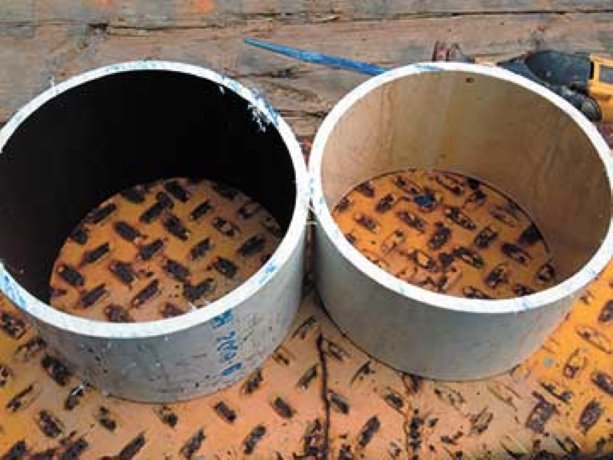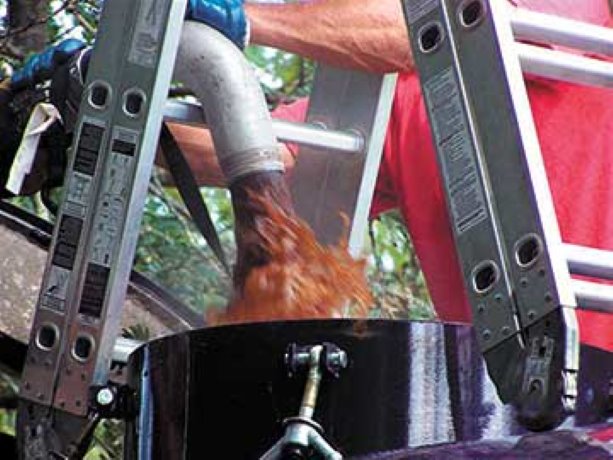A novel technology designed to clean watermains achieves that task using only a truckload of icy slush.
The treatment, known as ice pigging, has been successfully employed in European countries and elsewhere but has been introduced into the North American market by Atlanta-based company Utility Service Group (USG).
While traditional cleaning technologies include mechanical devices and chemicals, this environmentally-friendly method uses saltwater ice slurry to clean pipe interiors. The ice is carried along by system water pressure alone.
The concept of ice pigging was developed at the University of Bristol as a method of cleaning pipes for the food processing industry. However, the idea soon crossed over to local utility Bristol Water where it was first used to clean water pipes. Other projects followed in countries including the Netherlands, Germany and Australia.
Paul Treloar, ice pigging project manager with USG, likens the effect of the ice pig to that of a glacier, scouring out impurities as it passes, then absorbing them like a sponge.
“The advantage of an ice pig is that it can never get stuck in the pipe or damage any valves,” says Treloar. “If the ice pig is stopped for any reason, it simply melts.”
A mobile ice pigging rig travels from job to job, creating the ice slurry at the project site. The system consists of a chiller and a brine tank. The tank contains a 4.7 per cent brine solution made with food grade salt, about the same level of saltiness as sea water. The chiller takes the brine to a temperature of between -3 and -5 degrees C, a cooling process that can take up to a day and a half. The result is a US 2,700-gallon ice pig with a consistency similar to a 7-11 Slurpee.
“The ice pig is introduced into the water system through a fire hydrant or an inline valve and travels in the direction of the water flow,” says Treloar. “We can clean pipes ranging from 1/4” to 24” in diameter and we generally fill the pipe to about 20 per cent of its volume with slurry. We try to use existing valves so we can divide up a water line into segments that are the right length for the volume of ice slurry available, although we occasionally need to tap a new entry point.”
Ice pigging is typically scheduled for the coolest part of the day, allowing the ice slurry to last longer and scour more pipe.
“As the slurry travels through the pipe, we pull water samples from a nearby hydrant and watch the water first darken, then lighten as the water clears,” says Treloar.
The first North American city to contract full-scale water pigging services was Danbury, N.C. In August 2012, USG cleaned 18,500 feet of 6” polyvinyl chloride (PVC) water mains on behalf of client Stokes County. The job was broken down into four segments ranging from 1,500 to 8,000 feet in length.
USG recommends ice pigging for bio-films, iron, manganese, sediment and grit. More care must be taken with heavily tuberculated pipe containing large deposits of iron and manganese.
“We use a more gentle process in those situations, cleaning out the nooks and crannies while preserving the water quality by leaving the tuberculation undisturbed,” says Treloar.
USG has also used the process to clean sewer forcemains, which transmit wastewater under pressure. Ice pigging can clear forcemains of sediment, sand, debris, sludge and fats, oils and grease.
A recent project in Middlebury, Vt. represented the world’s longest ice pigging project for sewers, returning 12,000 feet of 16” and 18” ductile iron and PVC forcemain to original capacity.
USG has recently promoted ice pigging technology in Canadian cities including Sudbury and Cambridge. A June demonstration in Newmarket represents the first full-out demonstration of the technology in Canada.
“We’re capable of offering ice pigging services, to any place that our rig will drive,” says Treloar.

Above, an ice pigged brine runs into a septic line to help scour out impurities and absorb them. Below, the results of the saltwater ice slurry on a pipe, before (on left) and after (on right).
Photo: Utility Service Group"










Recent Comments
comments for this post are closed